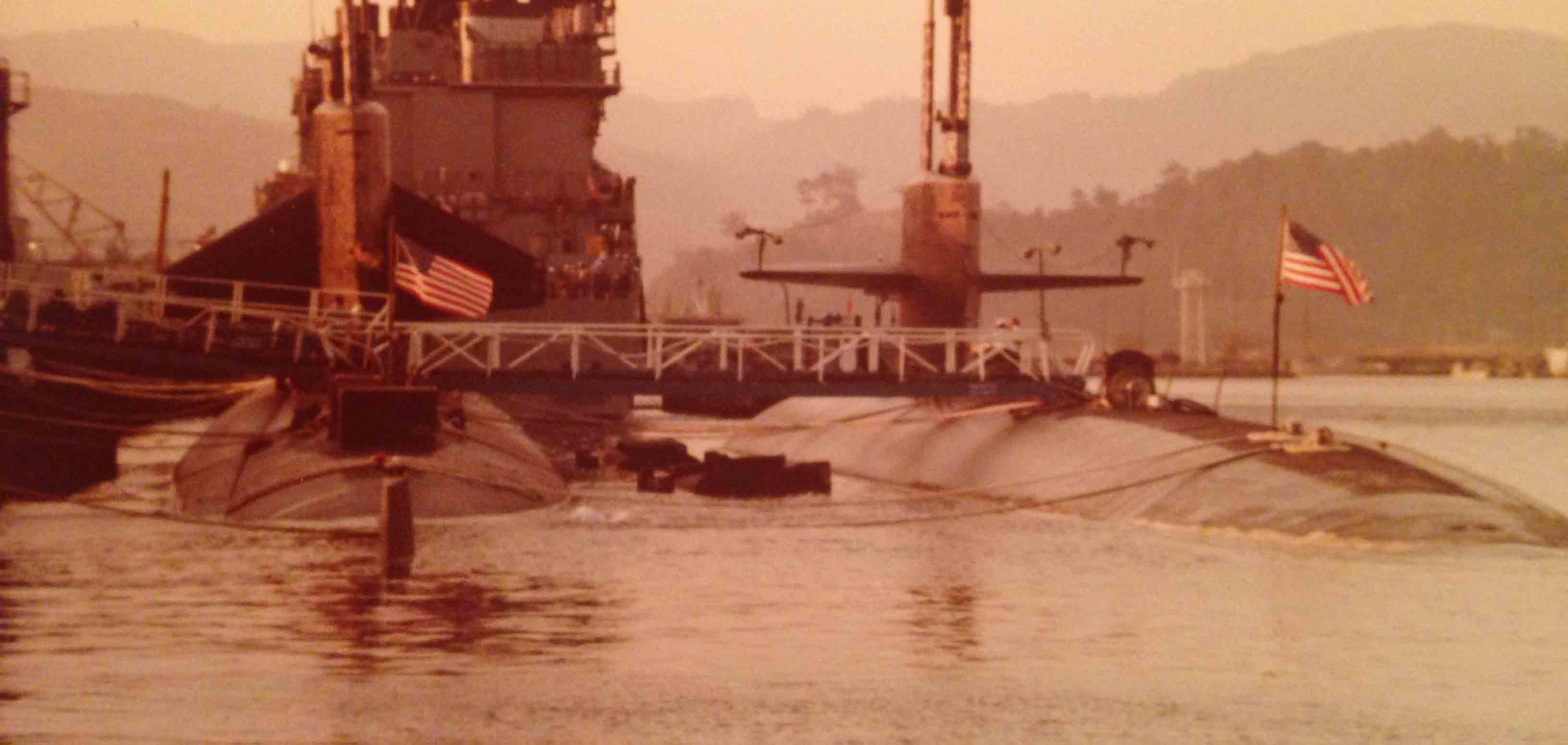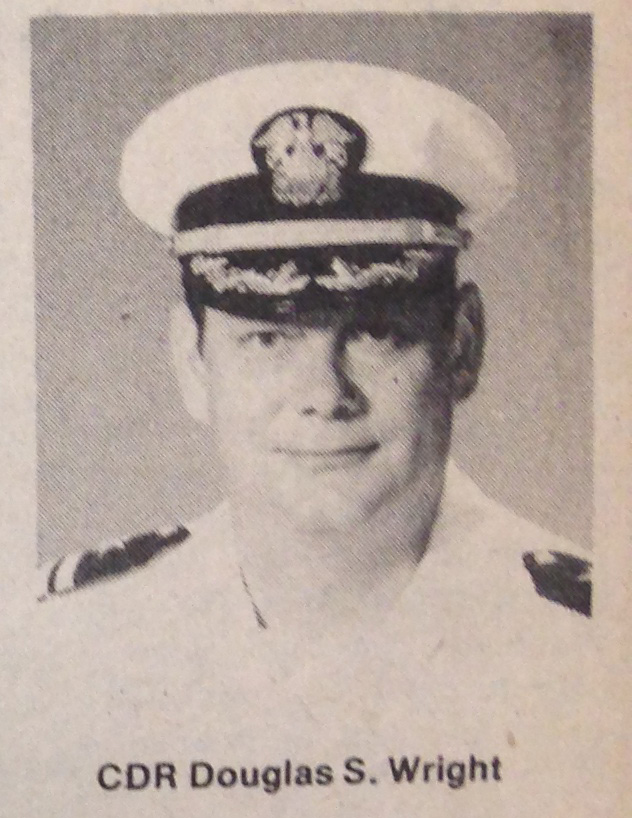How our micro-world in submarine sonar helped contribute to the end of the Cold War
Writer’s Note: Blogging is about life, gratitude for things irreplaceable like valued relationships, and, quite frankly, whatever I feel like writing about. So if you are interested in reading something a bit different, continue on.
There are times when you need to reflect on your past achievements to better understand what gave you the passion and drive to succeed or to identify what provided you a clear vision of what you were willing to dedicate a good portion of your life to.
I just spent a couple of days with a friend I haven’t seen in about 25 years. Despite our advancing age, and the wear of the years and highs and lows of life, there is a special bond of camaraderie that remains unscathed.
This caused me to remember the times and of our active duty service for the defense of our great nation.
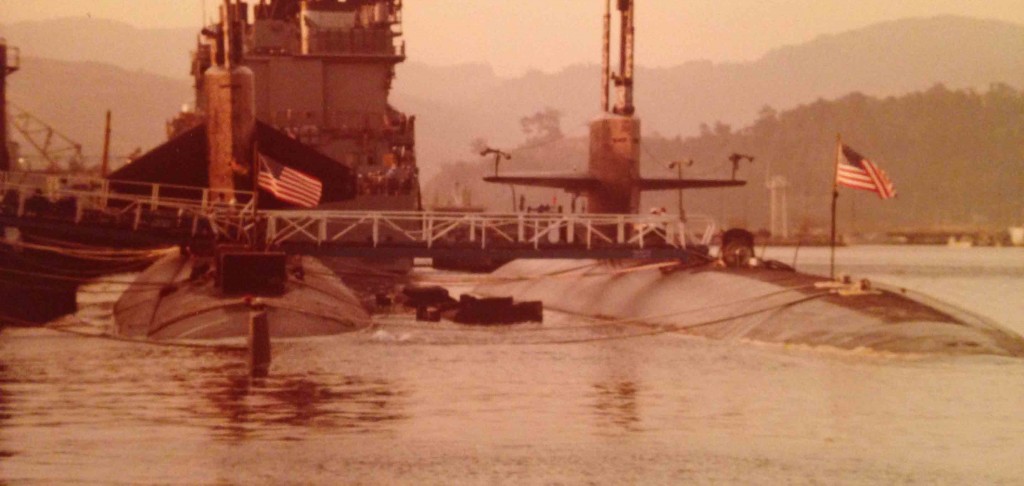
Behind a guided missile destroyer, A 637 Class Fast Attack (notice the vertically positioned sail planes) tied inboard of USS Bremerton in a WestPac port, Subic Bay, Philippines, circa 1983.- source: Challen Yee
.
Silent Service leading to the end of the Cold War
We served in the United States Navy, specifically in the Silent Service. Submariners are volunteers within a volunteer military. At the beginning of our service, the Vietnam War had ended about 5 years prior and with the rapid rise of tensions in the Middle East, the United States was on the verge of a new era that was led by a hostage crisis in Iran and a disastrous rescue attempt by American special operations.
The United States was in dire need of strong leadership and with it a strong military to face the demands of a world caught in the grips of the Cold War that had lasted 35 years since the end of World War II. Many people, like I did, grew up with the constant threat of a nuclear confrontation between the Superpowers, the United States and the Soviet Union.
The symbolic end of the first Cold War occurred in 1989 with the destruction of the Berlin Wall which preceded one of the greatest economic expansions in history. The decade of the 1980’s leading up to that time called for daring and boldness and even though the young generation of the 1970’s was called “Dazed and Confused” there were plenty of young men who rose to the call of Duty to man the sophisticated and deadly machines of the deep.
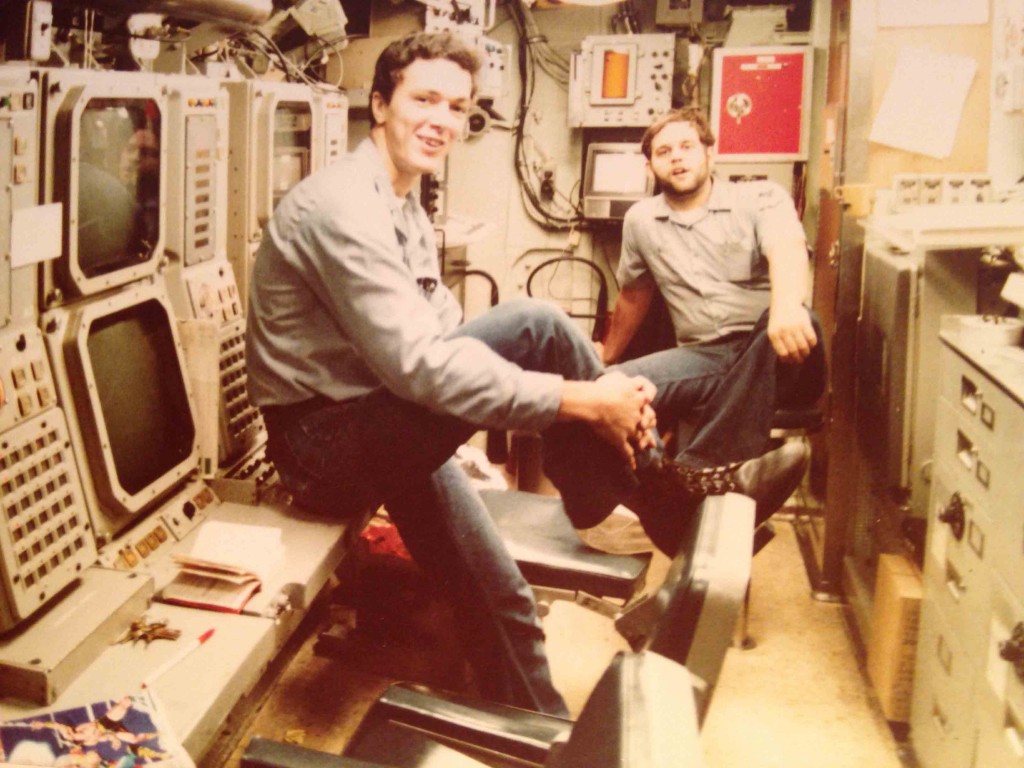
The sonar control room on Bremerton around 1983. Sonar Technician’s William D’Happart and Jeff Marcey enjoying a rare photo opportunity inport between working on the gear. – photo by Challen Yee
.
Q-5 SONAR- The Cadillac of Submarine ASW sensors
Though the modern submarine is vastly larger and in many ways more civilized that their World War II counterparts, those which established, through the unheralded courage of their crews, the devastating war fighting capabilities, they share a common trait: they are filled to the gills with equipment at the sacrifice of human comfort. No one joins the submarine service to have an easy life, rather they choose to be challenged and their ambitions tested in what is an essential part of the backbone in the defense and war-fighting capability of the nation.
A large portion of a submarine equipment space is dedicated to various sonar systems, consisting of the sensors for underwater warfare and navigation. The main sonar suite required specialized training, being a massive and high-tech IBM-based system known as the Q-5 (circa 1980’s).
At the time, the sonar technicians specializing in sonar operations and maintenance were, in large part, trained in San Diego, CA., an education process that could last a couple of years. This was a common training pipeline for qualified sonar enlistees who agreed to two extra years, making their first enlistment six full years instead of the normal four.
Jeff Marcey and I went through the advanced training for the Q-5, though Jeff was two months ahead of me. By some stroke of fate or perhaps the urging of an unrevealed senior Navy commander, we ended up being assigned to USS Bremerton (SSN 698), a recently commissioned Los Angeles Class Fast Attack submarine, newly home-ported in Pearl Harbor, Hawaii. Actually, my orders at the last minute were changed from USS Omaha (SSN-692), also stationed in Hawaii, to USS Bremerton.
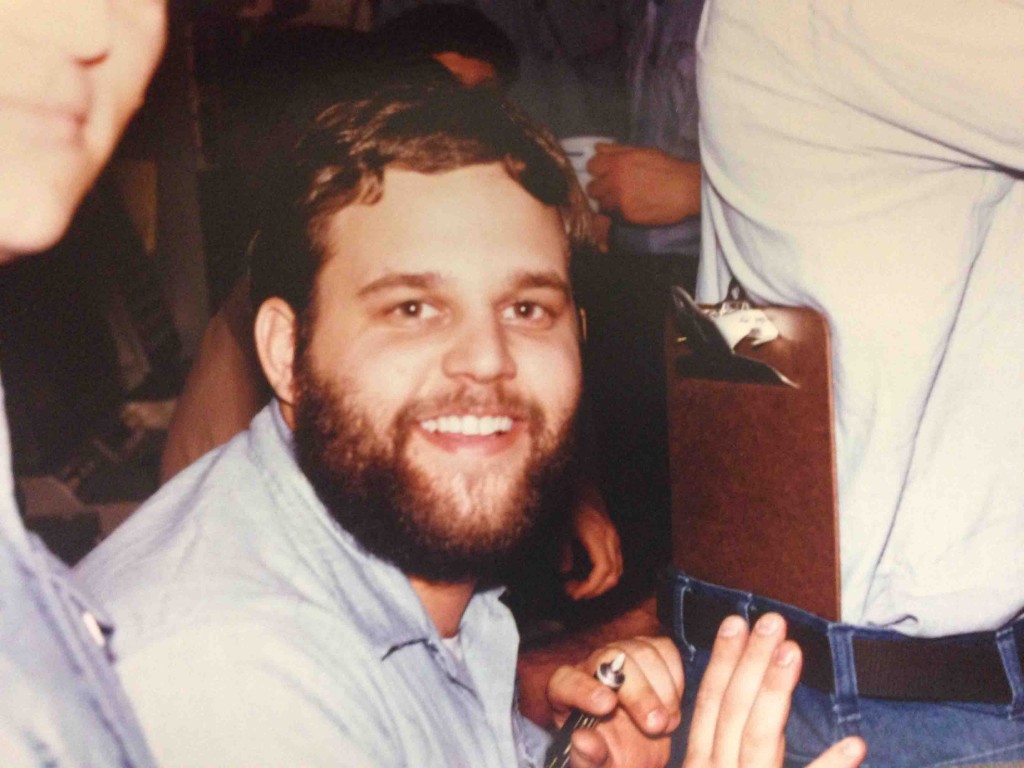
Jeff Marcey helping a shipmate stencil the back of their dungaree jeans aboard USS Bremerton. – Photo Challen Yee
Marcey had arrived to the boat a couple of months before I did and had to endure what few sonar technicians have had to endure.
Despite the truly dedicated efforts of the sonar technicians on the boat before Marcey arrived, Jeff’s advanced training and his critical thinking were crucial in correcting the problems with the sophisticated Q-5. He had to dive into a system that was full of errors and begin the painstaking process of clearing many of difficult problems that had been accumulating since the boat’s transit from Groton, Connecticut, to its homeport in Pearl Harbor and subsequent operations.
As submariners know, up to the first 12 months of being aboard a submarine are normally reserved for Qualifications and if you do not make the required progress, you become “dink” (delinquent) and, consequently, treated like a sub-human. However, a submarine without its sonar is like lipstick on a boar, a rather useless underwater platform ineffective in its primary goal of anti-submarine warfare (ASW).
.
Captain Douglas S. Wright
To add color to Jeff’s life, the Bremerton’s skipper, Commander Douglas S. Wright, who by all casual naval observers was one of the most aggressive submarine drivers of the time, was also one of the most intelligent ASW officers. His first assignment as a submariner in 1967 was as Sonar Officer onboard USS Pollack (SSN 603). With fast attack sonar in his blood early in his experiences as a Navy officer he would put a premium on battle readiness, which included having the sonar at peak performance.
So one of the unexpected unofficial qualifications steps for the new STS2/SU* Marcey was, when no one else was able to explain the supply chits to the Captain, he faced regular meetings with Captain Wright in his stateroom to explain why this $18,000 electronic module card or that $18,000 card needed to be replaced.
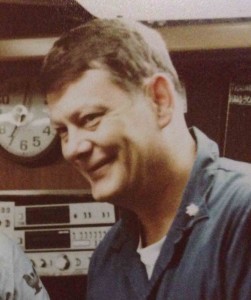
A casual photo of Captain D.S. Wright during a Dolphin Award presentation during undersea operations (1983).
Captain Wright was an extremely aggressive officer, and when ultimately, the condition of his submarine became at a high state of readiness (a testimony to every division aboard Bremerton), this allowed him to persuade Squadron commanders to allow his boat (our boat) to get assignments. In other words, Bremerton became a hot-running mission oriented boat that went places and did things. Wright was a tour de force and was able to make things happen.
His attitude and respect for sonar in port and during operations was very clear, and we all took great pride being under his command.
.
Opportunities to Lead
Marcey was proving his value by pushing himself to get the system straightened out when it was not possible for anyone else to mastermind the effort. This situation also opened up an opportunity for leadership in sonar as the leading sonar petty officer, Jerome Kline, worked with Jeff to make sure his Ship’s Qualifications did not fall behind.
When I arrived in Honolulu Airport in January 1983, I was greeted by Marcey and another shipmate and they gave me a ride to the barracks and there began my first day assigned to Bremerton. Although I knew him in passing in school, this was the beginning of a life long friendship.
.
Advanced Sonar Repair Tools – a mallot
Although I also played a major role in the maintenance and repair of the Q-5, I’ll always consider Jeff the real mover and shaker of the effort to cleanup the system problems. We ended up working extensively together sharing tasks. As advanced Q-5 system experts, we later took a 5+ week maintenance course taught at IBM’s plant in Manassas, Virginia. With our experience and growing familiarity with the system, we managed to create several legendary instances of repairing the system during at sea operations.
A noteworthy example was when our sonar chief and new leading petty officer (LPO) had spent hours during and underway watch to unsuccessfully repair a non-functioning monitor. When Jeff came on watch and the other two went down to the mess decks to get something to eat, Jeff, knowing what was wrong, took rubber mallot to the analog video card in question and the CRT sprang back into action.
When the Chief, LPO and sonar officer came back in, they were astounded that the equipment was up and running normally.
Dumfounded, they asked, “What happened?”
Roy Sokolowski, one of the watch standers, responded, “Just like the Fonz, Marcey banged on it and it worked.”
(“The Fonz” – Arthur Fonzerelli – was a character from the sitcom “Happy Days” in the mid-1970’s).
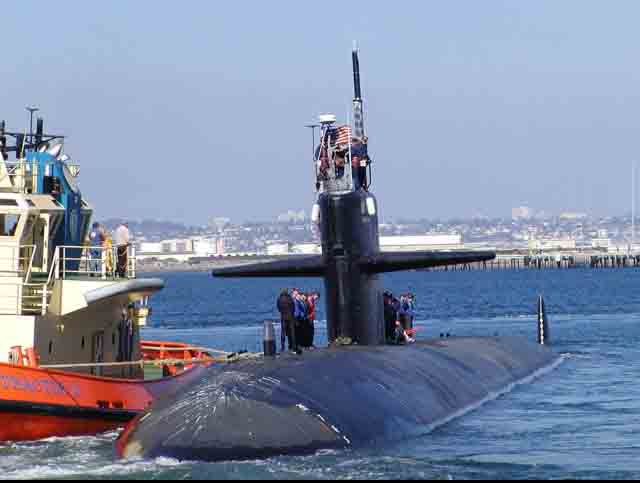
A more recent photo of USS Bremerton- currently (2014) US Navy’s oldest operational submarine. I served on from 1983-1986. Source – Facebook
.
The Oldest of the Old
A bit of interesting trivia: back in the 1980’s our Q-5 system was actually a transplant from the original USS Los Angeles SSN-688, our sonar system’s model number was “A3” and, at that time, the oldest seagoing operating Q-5 in the fleet (and perhaps one of the best operating systems despite being an older mod – we called it the Cadillac of Q-5’s). Now the Bremerton, as of this writing, is the oldest (longest serving) active submarine in the US Navy – – How time flies.
.
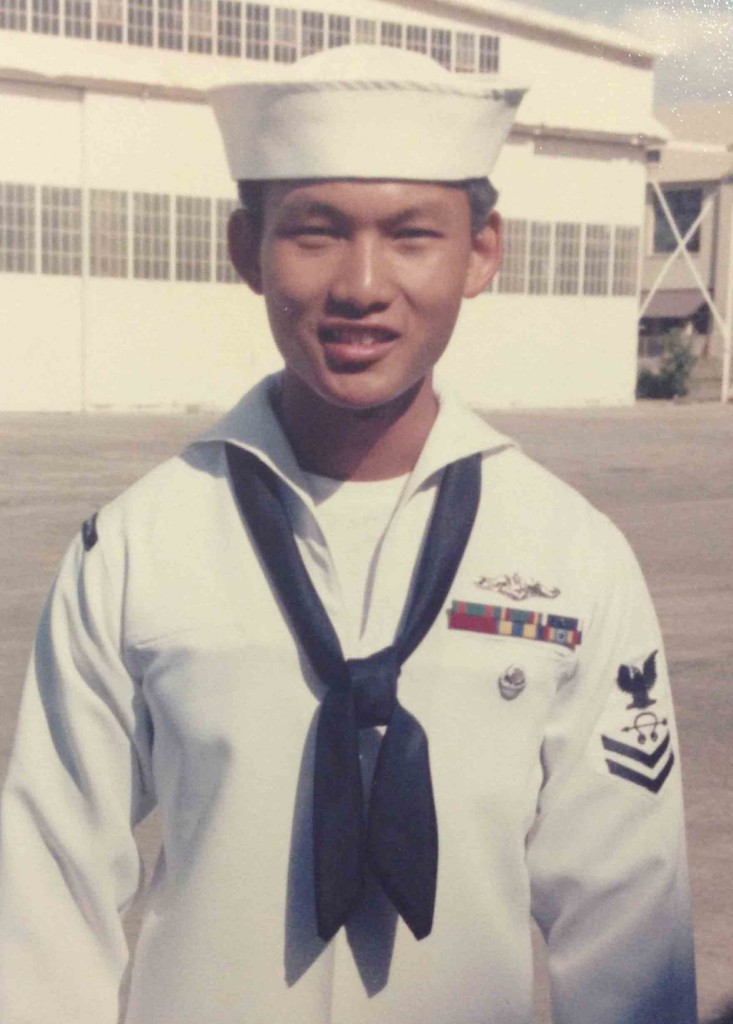
I reported to the Bremerton as a STS2/SU with no ribbons. The awards I received are an indication of the opportunity Captain Wright (followed by Captain Alan R. Beam) gave his crew by provided by producing a hot-running attack submarine. Of course you have to step up to the opportunities. This photo was taken the day i graduated from Navy Diver training on Ford Island (Pearl Harbor).
A note of Respect and Thanks
So to end this blogspot, I just want to appreciate all the submariners who formed our community for the leadership and camaraderie of both officers and of enlisted men who dared serve our country in the oceans deep. In the Sonar Division alone, we had a team of about 15 sonarmen, one of the largest divisions on a submarine, and many who rode our boat as “riders.” A lot of great guys who deserve credit for the work they contributed through operations, supervising, and repair and maintenance.
Now separated by my life in the Navy by decades, there is no doubt that the experience of being a submariner stands out as one that is difficult to surpass in the civilian world – an experience that will forever form a benchmark for teamwork, professionalism and pride of patriotic service.
.
Odd Coincidences
You’d never guess it, but Jeff’s birthday and mine fall on the same date, easy to remember, except Jeff is two years older. We are also both left-handed. He has a daughter named Hanna and I have a daughter named Hannah.

At home selfie taken recently as we were up late at night surfing the web on Jeff’s laptop. (L to R): Rhodora Atcha, Jeff Marcey, Challenson Yee and Challen Yee. Jeff still has being a practical joker in his blood. 😉
*Terminology SU vs SS
“SU” stands for Submariner Unqualified. All people who have never qualified in submarines before are non-qualified or SU. After a rigorous program of learning theoretical and practical knowledge of all systems and key operations on a submarine, detailed knowledge of your own space and passing a Qualification Board, you become an “SS” which means you are qualified and authorized to wear the Submarine Dolphins.
If you’ve received some value from this, please LIKE SHARE COMMENT
If you’d like to send me and email, please do at: challenyee@challenyee.com
I’ll see you… on the next page
…
